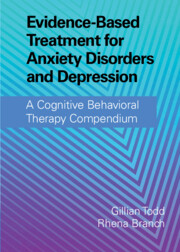 Evidence-Based Treatment for Anxiety Disorders and Depression
Evidence-Based Treatment for Anxiety Disorders and Depression Book contents
- Evidence-Based Treatment for Anxiety Disorders and Depression
- Evidence-Based Treatment for Anxiety Disorders and Depression
- Copyright page
- Contents
- Figures
- Tables
- Contributors
- 1 Introduction
- 2 The History and Philosophical Underpinnings of CBT:
- Part One Cognitive Behavioral Therapy for Anxiety Disorders
- Part Two Cognitive Behavioral Therapy for Posttraumatic Stress Disorder
- Part Three Cognitive Behavioral Therapy for Obsessive-Compulsive Disorder and Associated Disorders
- Part Four Cognitive Behavioral Therapy for Depression
- Part Five Complexity and Comorbidity in Anxiety Disorders and Depression:
- Part Six Specialist Applications of Cognitive Behavioral Therapy for Anxiety Disorders and Depression
- 24 The Application of CBT for Adults with Learning Disabilities
- 25 Cognitive Behavioral Therapy for Children and Adults with Autism
- 26 Adapting CBT for Treating Anxiety Disorders and Depression in Adults with ADHD
- 27 Adapting CBT for Children and Adolescents with Anxiety Disorders and Depression
- 28 Adapting Cognitive Behavioral Therapy for Older Adults with Anxiety Disorders and Depression
- 29 Cross-Cultural CBT
- Part Seven Future Developments
- Appendices
- Index
- References
28 - Adapting Cognitive Behavioral Therapy for Older Adults with Anxiety Disorders and Depression
from Part Six - Specialist Applications of Cognitive Behavioral Therapy for Anxiety Disorders and Depression
Published online by Cambridge University Press: 06 January 2022
- Evidence-Based Treatment for Anxiety Disorders and Depression
- Evidence-Based Treatment for Anxiety Disorders and Depression
- Copyright page
- Contents
- Figures
- Tables
- Contributors
- 1 Introduction
- 2 The History and Philosophical Underpinnings of CBT:
- Part One Cognitive Behavioral Therapy for Anxiety Disorders
- Part Two Cognitive Behavioral Therapy for Posttraumatic Stress Disorder
- Part Three Cognitive Behavioral Therapy for Obsessive-Compulsive Disorder and Associated Disorders
- Part Four Cognitive Behavioral Therapy for Depression
- Part Five Complexity and Comorbidity in Anxiety Disorders and Depression:
- Part Six Specialist Applications of Cognitive Behavioral Therapy for Anxiety Disorders and Depression
- 24 The Application of CBT for Adults with Learning Disabilities
- 25 Cognitive Behavioral Therapy for Children and Adults with Autism
- 26 Adapting CBT for Treating Anxiety Disorders and Depression in Adults with ADHD
- 27 Adapting CBT for Children and Adolescents with Anxiety Disorders and Depression
- 28 Adapting Cognitive Behavioral Therapy for Older Adults with Anxiety Disorders and Depression
- 29 Cross-Cultural CBT
- Part Seven Future Developments
- Appendices
- Index
- References
Summary
This chapter outlines some of the ways in which cognitive behavior therapy (CBT) for anxiety disorders and depression has been modified and adapted to the ageing older population. Aspects that are outlined include modifications to the process of conceptualization, which has been expanded to include relevant gerontological factors. The areas that should be incorporated into the assessment of older adults with anxiety and depression prior to starting therapy are delineated, with a focus on the characteristic features that color the presentation in the case of older adults. The changes that must be made in carrying out CBT for older adults with depression and anxiety disorders so that it is effective are described. This includes accommodations for cognitive changes and health-related difficulties as well as taking into consideration factors that are specific to the older population.
Keywords
- Type
- Chapter
- Information
- Evidence-Based Treatment for Anxiety Disorders and DepressionA Cognitive Behavioral Therapy Compendium, pp. 599 - 619Publisher: Cambridge University PressPrint publication year: 2022


